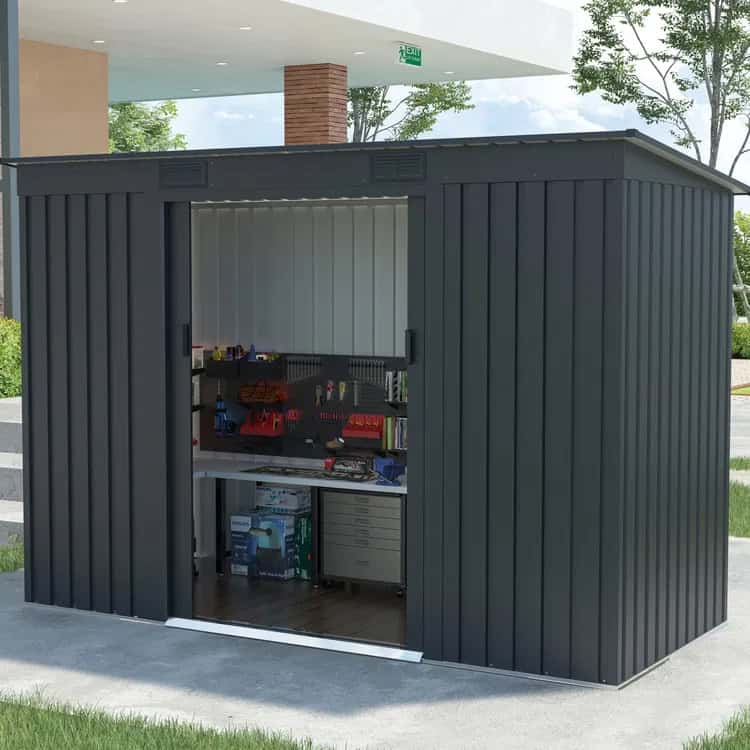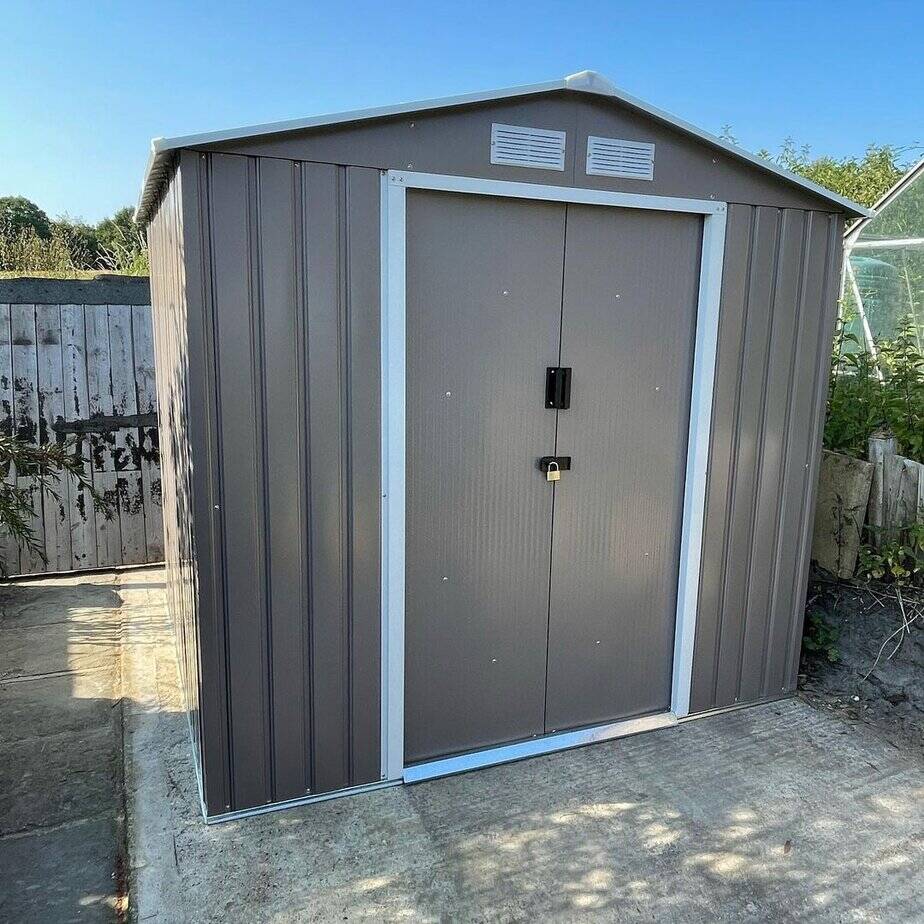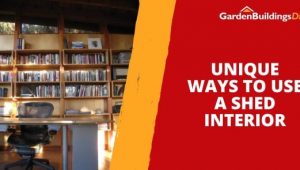Jump to:
Metal sheds are among the top contenders for garden storage options. The material often outperforms its wooden and plastic counterparts in so many ways. This guide is a great starting point if you’re considering one and want to know what you’re getting for your money.
Need to expand your search beyond just metal options? Our garden sheds guide explores every type of shed available. Otherwise, keep reading!Are Metal Sheds Any Good?

Yes, they are! Metal sheds are designed with the same intention as other sheds. That is to provide a cleared-out space for storage and protection from the harsh weather. You’ll also find various designs and sizes available to cater to different garden needs. What sets them apart is the material used for construction—metal. However, this often raises questions for buyers on whether or not it’s suitable for outdoor long-term use. We understand the confusion, as metal can sometimes be seen as less rigid than wood or as flexible as plastic. Technically, metal sheds are as reliable as those alternatives. The thing is, they come with features that can give them an edge in specific situations. This brings us to…
Metal Sheds Pros and Cons
Let’s take a look first at what makes metal garden storage worth considering:Durability and strength
Strong and durable construction is the crowning glory of metal sheds. Two types of metal are used, and one of them is galvanised steel. It’s coated with a layer of zinc, which makes the structure resistant to rust and corrosion. Not only that, but it also means the shed is better equipped to handle all kinds of weather, from rain to snow. Aluminium is the other option. While not as strong as steel, it’s lightweight yet gives a good mix of durability and ease of handling. This type of metal has anti-corrosion properties, too. In contrast, wood can be more vulnerable if it’s not treated or maintained. Over time, it may rot, split, or warp due to moisture, which can affect its long-term reliability. Plastic sheds are low-maintenance, but they can crack or warp in extreme heat or cold without proper care.Fire resistance
Galvanised steel and aluminium won’t ignite or add fuel to a fire, helping limit how quickly flames could spread. That doesn’t mean, though, that the contents inside are completely protected. Rather, the shed itself is far less likely to contribute to a fire like a timber one might.
Wooden and plastic sheds, in contrast, are much more vulnerable. Once exposed to enough heat or flame, they can catch fire and burn through faster, especially if untreated. Even with flame retardants, they don’t offer the same natural resistance as steel or aluminium. While no shed is entirely fireproof, metal sheds do offer an extra level of safety when it comes to fire.Low maintenance
One of the biggest draws of a metal shed is how little upkeep it needs. Unlike timber, there’s no need to stain, paint, or seal it every couple of years to keep it in good shape. And as mentioned, metal sheds already come pre-treated, particularly galvanised steel models. Plastic sheds are low-maintenance in the sense that they don’t need painting or sealing either. But over time, they can start to discolour or go brittle if exposed to strong sunlight for long periods. Metal generally holds up better, especially if it’s got a protective coating. As long as it’s looked after and not left scratched or dented for moisture to get in, it will stay in decent nick for years.Pest and rot resistance
Pests like termites, beetles, or fungi aren’t fond of steel or aluminium surfaces. This means there’s no food or shelter for them to munch on or settle in. That’s not all—metal sheds won’t swell or rot in damp conditions. It doesn’t wrap or rot when exposed to moisture for extended periods. They remain structurally sound, regardless, offering better protection for your stored items. This avoids the problems that wood can have in that regard.Security
As we’ve seen, the tough construction of a metal shed adds to its overall strength and makes it more secure from break-ins. Galvanised steel panels, in particular, are less vulnerable to tampering or forced entry, hence the better security. Moreover, many metal sheds come equipped with reinforced doors and secure locks.
Environmentally friendly
Galvanised steel and aluminium are recyclable. Once a shed reaches the end of its use, most of the metal can be taken to a recycling facility instead of going to a landfill. Or, if you’re into DIY projects, you can repurpose the materials for other uses. Many manufacturers also use recycled steel during production. This helps cut down on energy use and reduces the need for raw materials. Note: The actual environmental impact depends on how it’s made and the coatings used.Cost-effective
Metal sheds might have a higher upfront cost than wood or plastic models, but they tend to save you money over time. That’s mainly down to the low upkeep. Repairs are also less common, as metal doesn’t rot or warp. Note: Quality wooden and plastic sheds can last long, provided they’re looked after—it just takes a bit more effort. Now, onto the other side that might need a bit more thought:Condensation issues
Metal sheds can be prone to condensation, especially in damp or humid conditions. The temperature difference between the inside and outside can cause moisture to form on the interior surfaces. This can lead to dampness and potentially damage stored items over time. Solution: Good ventilation and insulation help reduce condensation. You can also use moisture absorbers or raise items off the ground to keep them dry.Limited insulation
Metal doesn’t naturally insulate, so these sheds can feel very warm in summer and quite cold in winter. Without proper insulation, the internal temperature tends to follow the weather outside. Solution: Adding insulation panels or lining the shed can help regulate the temperature. We have a guide on metal shed insulation that can help with this.Prone to dents and scratches
Metal sheds can pick up dents and scratches from knocks, garden tools, or falling branches. Minor marks won’t affect performance, but they can lead to rust if the protective coating gets damaged. Solution: Keep an eye out for scratches or chipped paint and touch them up when needed. We also recommend going for a thicker galvanised steel or aluminium shed if possible, as these tend to hold up better against impact.Garden Buildings Planning Permission
When it comes to metal sheds, you don’t need planning permission provided it meets specific criteria. However, there are considerations to keep in mind:Size and location
Regulations on the size and placement of your metal shed may vary depending on where you live. For instance, permission won’t be necessary if the shed’s eaves don’t exceed 2.5 metres, and the total height is between 3 and 4 metres. If it’s near property lines, roads, or other structures, it might need approval.Listed buildings or conservation areas
Is your property in a designated conservation area or part of a listed building? If so, stricter rules may apply. Speak with your local planning authority to find out what applies in your case.Height and appearance
The height and overall look of the shed can also affect whether you need permission. Sheds that are low-profile and blend into the surroundings are less likely to require it. Again, checking with your LPA to ensure you follow the rules is best. You can also visit their website for details specific to your area.Metal Sheds Maintenance
While metal sheds require less maintenance compared to other materials, that doesn’t mean they don’t need any care at all. There are a few simple ways to keep them in good condition and help them last longer, without too much effort.- Don’t overlook cleaning: Give your shed a quick clean every few months to stop dirt and grime from building up—two to three times a year will do. Avoid anything too abrasive that could damage the protective coating.
- Rust prevention: Even though most metal sheds are rust-resistant, they’re not invincible. Scratches or chips in the coating can leave bare metal exposed, which might start to corrode over time. Keep an eye out after storms, and patch up any marks with a bit of paint to stop rust from setting in.
- Lubricate hardware: Oil the hinges, locks, and handles occasionally, such as with WD-40. Doing so will help stop them from squeaking, jamming, or rusting over time.
- Inspect the roof: After heavy rain or storms, check the roof for dents, holes, or loose panels. Sort out any damage as soon as you spot it to avoid leaks and water damage.
- Ventilation: Good airflow helps prevent condensation, which can build up inside metal sheds. If yours doesn’t already have vents, add a few, especially if you store tools or anything moisture-sensitive.






